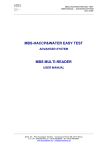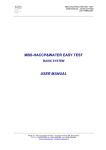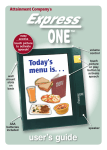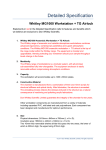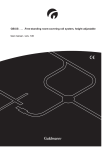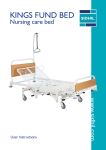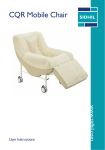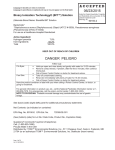Download MBS - User Manual - 2011-09 - MBS
Transcript
MBS-HACCP&ACQUE EASY TEST USER MANUAL – BASIC SYSTEM 2011 SEPTEMBER MBS-HACCP&ACQUE EASY TEST BASIC SYSTEM MBS MULTI-READER USER MANUAL M.B.S. Srl – Polo Tecnologico Tiburtino – Via Giacomo Peroni 386, 00131 Roma C.F. e P.I. 09423051003, tel. +39.06.40040358 – fax +39.06.40040364 www.emmebiesse.net – [email protected] MBS-HACCP&ACQUE EASY TEST USER MANUAL – BASIC SYSTEM 2011 SEPTEMBER TABLE OF CONTENTS 1.1 Introduction 3 1.2 How to use 5 1.2.1 Solid sample 6 1.2.2 Liquid sample 9 1.2.3 Surface analysis 11 1.3 Color scales and correlation tables 14 1.3.1 Total Viable Count – CBT-A01 14 1.3.2 Coliforms survey – CO-A02 14 1.3.3 E. coli survey – CO-A02 15 1.3.4 Enterobacteriaceae survey – EB-A04 15 1.3.5 Staphylococcus aureus survey – SP-A04 15 1.3.6 Pseudomonas aeruginosa survey – PAO-A05 16 1.3.7 Salmonella spp. survey – SL-A06 16 1.3.8 Listeria spp. survey – LY-A07 16 1.3.9 Enterococcus faecalis survey – EF-A09 17 1.3.10 Aspergillus spp. survey – AS-A10 17 1.3.11 Saccharomyces spp. survey – SC-A11 17 1.3.12 Clostridium perfringens survey – CP-A17 18 M.B.S. Srl – Polo Tecnologico Tiburtino – Via Giacomo Peroni 386, 00131 Roma C.F. e P.I. 09423051003, tel. +39.06.40040358 – fax +39.06.40040364 www.emmebiesse.net – [email protected] page 2 of 18 MBS-HACCP&ACQUE EASY TEST USER MANUAL – BASIC SYSTEM 2011 SEPTEMBER 1.1 Introduction Dear User, thank you for purchasing MBS-HACCP&ACQUE EASY TEST, an innovative rapid colorimetric system to perform microbiological tests on food, water and surfaces, developed in collaboration with Roma Tre University. The method of analysis is based on the observation of the color change in the suspension formed in the analysis vial used when the test sample is added: the suspension changes color (turns) if there are microorganisms, the greater the amount of microorganisms, the more rapid is the change of color. The main features of the MBS-HACCP&ACQUE EASY TEST are: Speed: analysis time, from preparation to the achievement of results, from 2 to 5 times less than traditional methods; Ease of use: Anyone, anywhere can do the analysis without the need for other reagents or special equipment; Sensitivity: you can detect even a single microorganism present in the sample; Selectivity: it can detect different species of microbial organisms to the experimental limit of 99.999%; Cost: The cost of each analysis turns out to be 2 to 4 times cheaper than traditional methods. The MBS method has been validated according to ISO 16140:2003 "Microbiology of food and animal feeding stuffs - Protocol for the validation of alternative methods". M.B.S. Srl – Polo Tecnologico Tiburtino – Via Giacomo Peroni 386, 00131 Roma C.F. e P.I. 09423051003, tel. +39.06.40040358 – fax +39.06.40040364 www.emmebiesse.net – [email protected] page 3 of 18 MBS-HACCP&ACQUE EASY TEST USER MANUAL – BASIC SYSTEM 2011 SEPTEMBER Available reagents for the selective search of the following microorganisms: 1. Total Viable Count – CBT-A01; 2. Coliforms (Totals ed E. coli) – CO-A02; 3. Enterobacteriaceae – EB-A03; 4. Staphylococcus aureus – SP-A04; 5. Pseudomonas aeruginosa – PAO-A05; 6. Salmonella spp. – SL-A06; 7. Listeria spp. – LY-A07; 8. Enterococcus faecalis – EF-A09; 9. Molds (Aspergillus spp.) – AS-A10; 10. Yeasts (Saccharomyces spp.) – SC-A11; 11. Clostridium perfringens – CP-A17. M.B.S. Srl – Polo Tecnologico Tiburtino – Via Giacomo Peroni 386, 00131 Roma C.F. e P.I. 09423051003, tel. +39.06.40040358 – fax +39.06.40040364 www.emmebiesse.net – [email protected] page 4 of 18 MBS-HACCP&ACQUE EASY TEST USER MANUAL – BASIC SYSTEM 2011 SEPTEMBER 1.2 How to use The kit comes in a pack containing all the material for the analysis: the reaction vial (vial) and a vial of distilled water (vial of water). To perform the analysis you must also have a bacteriology thermostatic incubator programmable to 30 °, 37 ° or 44 °C. Before handling the vials and proceeding with the analysis a thorough hand washing is recommended. The performance analysis can be summarized into 5 phases: opening, insertion of the sample, early analysis, order analysis and sterilization. It also differs by type of sample to be analyzed: solid sample, liquid sample, or surface analysis. M.B.S. Srl – Polo Tecnologico Tiburtino – Via Giacomo Peroni 386, 00131 Roma C.F. e P.I. 09423051003, tel. +39.06.40040358 – fax +39.06.40040364 www.emmebiesse.net – [email protected] page 5 of 18 MBS-HACCP&ACQUE EASY TEST USER MANUAL – BASIC SYSTEM 2011 SEPTEMBER 1.2.1 Solid sample Step 1. Opening • Open the vial, taking care to flip the cap so that the inner surface does not come into contact with the surface to avoid contamination. Step 2. Inserting the sample • Take a small aliquot of the food (no bigger than a grain of maize, corresponding to approximately 1 g) with a tool used during the processing of the food itself and insert it into the vial (alternatively you can use sterile tweezers). Note: the size or the exact weight of the sample to be examined is not important. Infact, the statistical variability microbiological examination of food samples is such that no method of analysis (including the reference method) has a variability of less than + 60-70%. Therefore, the analysis has the same intrinsic value if it fits into a 1 g vial 2 g or 0.5 g. This variability is due both to the method of analysis, and to the sample itself since these microorganisms often grow in grouped colonies and therefore are not dispersed evenly in the middle. Note: for inserting the sample into the vial, we recommend using a tool used during the processing of the food itself, since by so doing, you will be able to detect any contamination of the food due to extrinsic causes. Step 3. Start analysis • Open the vial of water supplied with the reaction vial, and insert the entire contents of the vial itself. • Mix by inverting the vial several times to completely M.B.S. Srl – Polo Tecnologico Tiburtino – Via Giacomo Peroni 386, 00131 Roma C.F. e P.I. 09423051003, tel. +39.06.40040358 – fax +39.06.40040364 www.emmebiesse.net – [email protected] page 6 of 18 MBS-HACCP&ACQUE EASY TEST USER MANUAL – BASIC SYSTEM 2011 SEPTEMBER dissolve the reagent (twenty seconds). • If necessary, fill in the Quality Control Sheet. • Place the vial in the incubator thermostat. Note: the vial grows 2 liquid phases: the upper one consisting of white transparent oil (does not change during the analysis), formed at the bottom of the vial from the water with which the reagent is dissolved. The color of the second phase will develop fully within 15-20 minutes from the dissolution of the reagent and that is what must be observed for the evaluation of the results of the analysis. Step 4. Control of the analysis results • You only need to check the color of the vial once, after a set number of hours depending on the type of analysis. This number of hours does not depend only on the type of analysis, but includes the operational limit of acceptable bacterial load in the sample (the generally accepted limits for the type of sample taken by law, are shown, by way of illustration on the Quality Control Sheets, ,). • Compare the color of the vial with the correlation table set out in paragraph 1.3 or in Quality Control Sheet. • If you have started the compilation of the Quality Control Sheet, fill it in with the result of the analysis. • In the case of analysis for detection of E. coli and only if the result is positive (bright yellow vial), you can perform a test to confirm the presence of E. coli, adding 3-5 drops of Kovacs reagent to the vial at the end of the analysis, before the sterilization. If there is E. coli, within a few seconds you will see the development of a small surface layer of purple-red liquid. Note: to make the test for confirmation of E. coli, open the vial carefully, avoiding contamination with the liquid contained in it, because if the color is tacked, the vial will contain a significant number of bacteria and it is therefore preferable to use disposable gloves, even non-sterile, for the operation of opening the vial. If you come in contact M.B.S. Srl – Polo Tecnologico Tiburtino – Via Giacomo Peroni 386, 00131 Roma C.F. e P.I. 09423051003, tel. +39.06.40040358 – fax +39.06.40040364 www.emmebiesse.net – [email protected] page 7 of 18 MBS-HACCP&ACQUE EASY TEST USER MANUAL – BASIC SYSTEM 2011 SEPTEMBER with the liquid, wash the affected area immediately and thoroughly with antibacterial soap or normal soap and then with a disinfectant. Step 5. Post-analysis sterilization • Without opening the vial, firmly press the top of the cap and shake for about 10 seconds. The addition of the sterilizing agent can cause a color change. After 510 minutes the contents of the vial are completely sterilized. Note: when the sterilization of the microorganisms are destroyed, the reagents are rendered inert and the vial can be safely disposed of as a "sanitary waste nonhazardous" according to the D.M. of 25/5/89. Such waste, after sterilization, can be disposed of in the same way as drugs which have expired. M.B.S. Srl – Polo Tecnologico Tiburtino – Via Giacomo Peroni 386, 00131 Roma C.F. e P.I. 09423051003, tel. +39.06.40040358 – fax +39.06.40040364 www.emmebiesse.net – [email protected] page 8 of 18 MBS-HACCP&ACQUE EASY TEST USER MANUAL – BASIC SYSTEM 2011 SEPTEMBER 1.2.2 Liquid sample Step 1. Opening • Open the vial, taking care to flip the cap so that the inner surface does not come into contact with the surface to avoid contamination. Step 2. Inserting the sample • Using a pasteur dropper, sterile, disposable (supplied on request) draw a quantity of fluid to examine and introduce about 1 ml of that liquid into the vial. Step 3. Start analysis • Open the vial of water supplied with the reaction vial, and insert the entire contents of the vial itself. • Mix by inverting the vial several times to completely dissolve the reagent (twenty seconds). • If necessary, fill in the Quality Control Sheet. • Place the vial in the incubator thermostat. Note: the vial grow in 2 liquid phases: the upper one consisting of white oil transparent (does not change during the analysis), formed at the bottom of the vial from the water with which the reagent is dissolved. The color of the second phase will develop fully within 15-20 minutes from the dissolution of the reagent and that is what must be observed for the evaluation of the results of the analysis. Step 4. Control of the analysis result • You only need to check the color of the vial once, after a set number of hours depending on the type of analysis. This number of hours does not depend only on the type of analysis, but includes the operational limit of acceptable bacterial load in the sample (the generally accepted limits for the type of sample taken by M.B.S. Srl – Polo Tecnologico Tiburtino – Via Giacomo Peroni 386, 00131 Roma C.F. e P.I. 09423051003, tel. +39.06.40040358 – fax +39.06.40040364 www.emmebiesse.net – [email protected] page 9 of 18 MBS-HACCP&ACQUE EASY TEST USER MANUAL – BASIC SYSTEM 2011 SEPTEMBER law, are shown, by way of illustration on the Quality Control Sheets). • Compare the color of the vial with the correlation table set out in paragraph 1.3 or in Quality Control Sheet. • If you have started the compilation of the Quality Control Sheet, fill it in with the result of the analysis. • In the case of analysis for detection of E. coli and only if the results are positive (bright yellow vial), you can perform a test to confirm the presence of E. coli, adding 3-5 drops of Kovacs reagent to the vial at the end of the analysis, before the sterilization. If there is E. coli, within a few seconds you will see the development of a small surface layer of purple-red liquid. Note: to make the test for confirmation of E. coli, open the vial carefully, avoiding contamination with the liquid contained in it, because if the color is tacked, the vial will contain a significant number of bacteria and it is therefore preferable to use disposable gloves, even non-sterile, for the operation of opening the vial. If you come in contact with the liquid, wash the affected area immediately and thoroughly with antibacterial soap or normal soap and then with a disinfectant. Step 5. Post-analysis sterilization • Without opening the vial, firmly press the top of the cap and shake for about 10 seconds. The addition of the sterilizing agent can cause a color change. After 510 minutes the contents of the vial are completely sterilized. Note: when the sterilization of the microorganisms are destroyed, the reagents are rendered inert and the vial can be safely disposed of as a "sanitary waste nonhazardous" according to the D.M. of 25/5/89. Such waste, after sterilization, can be disposed of in the same way as drugs which have expired. M.B.S. Srl – Polo Tecnologico Tiburtino – Via Giacomo Peroni 386, 00131 Roma C.F. e P.I. 09423051003, tel. +39.06.40040358 – fax +39.06.40040364 www.emmebiesse.net – [email protected] page 10 of 18 MBS-HACCP&ACQUE EASY TEST USER MANUAL – BASIC SYSTEM 2011 SEPTEMBER 1.2.3 Surface analysis Step 1. Preparation of the reaction vial • Open the vial of water supplied with the vial for analysis, and insert the entire contents of the reaction vial itself. • Mix by inverting the vial several times to completely dissolve the reagent (twenty seconds). Note: after dissolution of the reagent, it is advisable to unscrew the reaction vial cap of analysis to facilitate subsequent operations. Step 2. Sampling • Open the cotton swab vial containing the neutralizing solution. • Rub the swab on the surface trying to cover a square area of about 10 cm per side. Note: do not re-insert the swab into the vial containing the neutralizing solution. Step 3. Start analysis • Open the previously prepared reaction vial. • Insert the swab into reaction vial. • If necessary, fill in the Quality Control Sheet. • Place the vial in the incubator thermostat. Note: you can reseal the vial containing the neutralizing solution with the cap of reaction vial before disposal. M.B.S. Srl – Polo Tecnologico Tiburtino – Via Giacomo Peroni 386, 00131 Roma C.F. e P.I. 09423051003, tel. +39.06.40040358 – fax +39.06.40040364 www.emmebiesse.net – [email protected] page 11 of 18 MBS-HACCP&ACQUE EASY TEST USER MANUAL – BASIC SYSTEM 2011 SEPTEMBER Note: the vial will grow in 2 liquid phases: the upper one consisting of white transparent oil (does not change during the analysis), formed at the bottom of the vial from the water with which the reagent is dissolved. The color of the second phase will develop fully within 15-20 minutes from the dissolution of the reagent and that is what must be observed for the evaluation of the results of the analysis. Step 4. Control of the analysis result • You only need to check the color of the vial only once, after a set number of hours depending on the type of analysis. This number of hours does not depend only on the type of analysis, but includes the operational limit of acceptable bacterial load in the sample (the generally accepted limits for the type of sample taken by law, are shown, by way of illustration on the Quality Control Sheet).. • Compare the color of the vial with the correlation table set out in paragraph 1.3 or in Quality Control Sheet. • If you have started the compilation of the Quality Control Sheet, fill it in with the result of the analysis. • In the case of analysis for detection of E. coli and only if the result is positive (bright yellow vial), you can perform a test to confirm the presence of E. coli, adding 3-5 drops of Kovacs reagent to the vial at the end of the analysis, before the sterilization. If there is E. coli, within a few seconds you will see the development of a small surface layer of purple-red liquid. Note: to make the test for confirmation of E. coli, open the vial carefully, avoiding contamination with the liquid contained in it, because if the color is tacked, the vial will contain a significant number of bacteria and it is therefore preferable to use disposable gloves, even non-sterile, for the operation of opening the vial. If you come in contact with the liquid, wash the affected area immediately and thoroughly with antibacterial soap or normal soap and then with a disinfectant. M.B.S. Srl – Polo Tecnologico Tiburtino – Via Giacomo Peroni 386, 00131 Roma C.F. e P.I. 09423051003, tel. +39.06.40040358 – fax +39.06.40040364 www.emmebiesse.net – [email protected] page 12 of 18 MBS-HACCP&ACQUE EASY TEST USER MANUAL – BASIC SYSTEM 2011 SEPTEMBER Step 5. Post-analysis sterilization • Without opening the vial, firmly press the top of the cap and shake for about 10 seconds. The addition of the sterilizing agent can cause a color change. After 510 minutes the contents of the vial is completely sterilized. Note: with the sterilization of the microorganisms are destroyed, the reagents are rendered inert and the vial can be safely disposed of as a "sanitary waste nonhazardous" according to the D.M. of 25/5/89. Such waste, after sterilization, can be disposed of in the same way as drugs which have expired. M.B.S. Srl – Polo Tecnologico Tiburtino – Via Giacomo Peroni 386, 00131 Roma C.F. e P.I. 09423051003, tel. +39.06.40040358 – fax +39.06.40040364 www.emmebiesse.net – [email protected] page 13 of 18 MBS-HACCP&ACQUE EASY TEST USER MANUAL – BASIC SYSTEM 2011 SEPTEMBER 1.3 Color scales and correlation tables As required by law, the concentration of bacteria is expressed in CFU/g or CFU/ml or CFU/cm 2 (Colony Forming Units), respectively, for the analysis of solid or liquid samples or surfaces, by analogy with the results expressed with the traditional analysis, even if the MBS method is based on the detection of bacterial metabolism and not on the replication of microorganisms. The credits (approximately) correspond to individual bacterial cells. 1.3.1 Total Viable Count – CBT-A01 1.3.2 Coliforms survey – CO-A02 M.B.S. Srl – Polo Tecnologico Tiburtino – Via Giacomo Peroni 386, 00131 Roma C.F. e P.I. 09423051003, tel. +39.06.40040358 – fax +39.06.40040364 www.emmebiesse.net – [email protected] page 14 of 18 MBS-HACCP&ACQUE EASY TEST USER MANUAL – BASIC SYSTEM 2011 SEPTEMBER 1.3.3 E. coli survey – CO-A02 1.3.4 Enterobacteriaceae survey – EB-A04 1.3.5 Staphylococcus aureus survey – SP-A04 M.B.S. Srl – Polo Tecnologico Tiburtino – Via Giacomo Peroni 386, 00131 Roma C.F. e P.I. 09423051003, tel. +39.06.40040358 – fax +39.06.40040364 www.emmebiesse.net – [email protected] page 15 of 18 MBS-HACCP&ACQUE EASY TEST USER MANUAL – BASIC SYSTEM 2011 SEPTEMBER 1.3.6 Pseudomonas aeruginosa survey – PAO-A05 1.3.7 Salmonella spp. survey – SL-A06 1.3.8 Listeria spp. survey – LY-A07 M.B.S. Srl – Polo Tecnologico Tiburtino – Via Giacomo Peroni 386, 00131 Roma C.F. e P.I. 09423051003, tel. +39.06.40040358 – fax +39.06.40040364 www.emmebiesse.net – [email protected] page 16 of 18 MBS-HACCP&ACQUE EASY TEST USER MANUAL – BASIC SYSTEM 2011 SEPTEMBER 1.3.9 Enterococcus faecalis survey – EF-A09 1.3.10 Aspergillus spp. survey – AS-A10 1.3.11 Saccharomyces spp. survey – SC-A11 M.B.S. Srl – Polo Tecnologico Tiburtino – Via Giacomo Peroni 386, 00131 Roma C.F. e P.I. 09423051003, tel. +39.06.40040358 – fax +39.06.40040364 www.emmebiesse.net – [email protected] page 17 of 18 MBS-HACCP&ACQUE EASY TEST USER MANUAL – BASIC SYSTEM 2011 SEPTEMBER 1.3.12 Clostridium perfringens survey – CP-A17 M.B.S. Srl – Polo Tecnologico Tiburtino – Via Giacomo Peroni 386, 00131 Roma C.F. e P.I. 09423051003, tel. +39.06.40040358 – fax +39.06.40040364 www.emmebiesse.net – [email protected] page 18 of 18


















